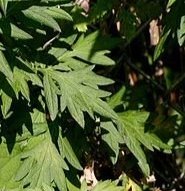Tox in The Land: #NaturalAbortion. The facts you didn't see on TikTok this summer!
Over 157,000 views
#Pennyroyaltea (Pennyroyal)
Derived from leaves of Mentha pulegium
Used as an insect repellent, mint flavoring in tea, abortifacient
Available as a tea or a concentrated oil
Oil is highly toxic (can cause death with ingestion of 15 mL)
Mechanism of toxicity
Pulegone is toxic to multiple organs as an enzyme inhibitor
Pulegone is also converted to toxic metabolites that deplete glutathione stores in the liver
Menthofurane is a hepatotoxic metabolite that inhibits CYP2A6 and contributes to centrilobular hepatic necrosis
Pulegone and its metabolites may also cause lung necrosis
Toxic effects
Nausea, vomiting, abdominal pain
Liver failure
Renal insufficiency
Cardiopulmonary collapse
Syncope
Seizure
Coma
Death
Treatment
No antidote
N-acetylcysteine has been given to patients given similar mechanism to Tylenol toxicity
#Mugwort
Derived from the leaves of Artemisia vulgaris
Used to induce menstruation, as an abortifacient, treat digestive problems, antioxidant, insecticide
Available as dried leaves, oil, tinctures, teas, pills
Toxicity
Generally well tolerated
Can be toxic when the oil is ingested
Oil contains high concentrations of camphor (10-47%) and thujone (9-21%)
Can lead to nausea, vomiting, headache
Neurotoxic and can lead to seizures
#BlueCohosh
Derived from the roots or rhizomes of Caulophyllum thalictroides
Traditionally used to induce labor and menstruation, as an abortifacient, anti-inflammatory, anti-pyretic
Available as root powders, capsules and liquid extracts
Toxicity
Contains alkaloids like N-methylcytosine, which has nicotinic effects
Nicotinic toxicity – tachycardia, diaphoresis, abdominal pain, muscle weakness, fasciculations
Contains saponins, which are glycosides that constrict coronary vessels
Case studies have reported association with perinatal stroke, acute MI, heart failure and multiple organ injury
#BlackCohosh
Derived from the roots or rhizomes of Actaearacemosa
Also known as black root, black snakeroot, bugbane
Claimed to have estrogen-like effects
Used primarily for menopausal symptoms, to induce labor, and as abortifacient
Very limited evidence supporting these claims
Available as a tincture or capsule
Toxicity
Nausea, vomiting
Hepatotoxicity
~2-12 weeks latency period
Hepatotoxicity ranges from moderate elevations in liver enzymes to acute hepatic failure and death
Exact mechanism is unknown, but may be immunologically mediated
POST BY: VICTORIA ADOMSHICK (MS4, CWRU)
FACULTY EDITING BY: DR. LAUREN PORTER (MEDICAL TOXICOLOGIST)
References
Anderson IB, Mullen WH, Meeker JE, Khojasteh-BakhtSC, Oishi S, Nelson SD, Blanc PD. Pennyroyal toxicity: measurement of toxic metabolite levels in two cases and review of the literature. Ann Intern Med. 1996 Apr 15;124(8):726-34. doi: 10.7326/0003-4819-124-8-199604150-00004. PMID: 8633832.
Khojasteh-Bakht SC, Koenigs LL, Peter RM, Trager WF, Nelson SD. (R)-(+)-Menthofuran is a potent, mechanism-based inactivator of human liver cytochrome P450 2A6. Drug MetabDispos. 1998 Jul;26(7):701-4. PMID: 9660853.
LiverTox: Clinical and Research Information on Drug-Induced Liver Injury [Internet]. Bethesda (MD): National Institute of Diabetes and Digestive and Kidney Diseases; 2012-. Black Cohosh. [Updated 2020 Nov 4]. Available from: https://www.ncbi.nlm.nih.gov/books/NBK547990/
Lontos S, Jones RM, Angus PW, Gow PJ. Acute liver failure associated with the use of herbal preparations containing black cohosh. Med J Aust. 2003;179:390–1.
Rader JI, Pawar RS. Primary constituents of blue cohosh: quantification in dietary supplements and potential for toxicity. Anal Bioanal Chem. 2013 May;405(13):4409-17. doi: 10.1007/s00216-013-6783-7. Epub 2013 Feb 19. PMID: 23420136.
Abiri R, Silva ALM, de Mesquita LSS, de Mesquita JWC, Atabaki N, de Almeida EB Jr, Shaharuddin NA, Malik S. Towards a better understanding of Artemisia vulgaris: Botany, phytochemistry, pharmacological and biotechnological potential. Food Res Int. 2018 Jul;109:403-415.
Siegel E, Wason S. Camphor toxicity. Pediatr Clin North Am. 1986 Apr;33(2):375-9. doi: 10.1016/s0031-3955(16)35008-8. PMID: 3515302.
Pelkonen O, Abass K, Wiesner J. Thujone and thujone-containing herbal medicinal and botanical products: toxicological assessment. Regul Toxicol Pharmacol. 2013 Feb;65(1):100-7. doi: 10.1016/j.yrtph.2012.11.002. Epub 2012 Nov 28. PMID: 23201408.




